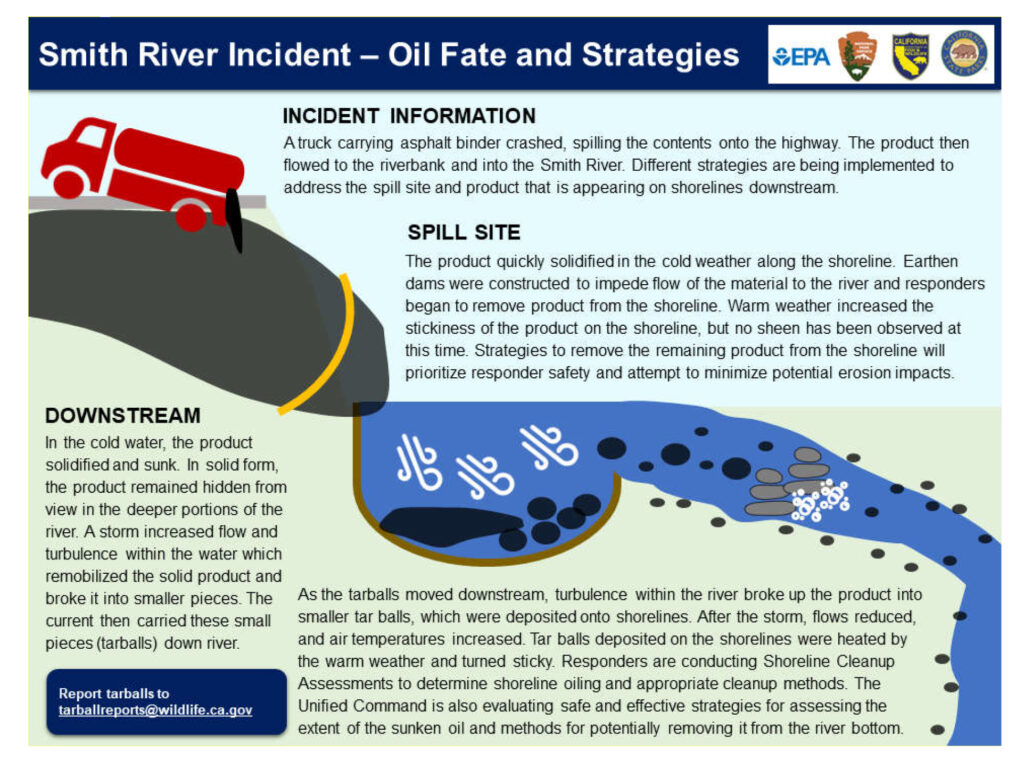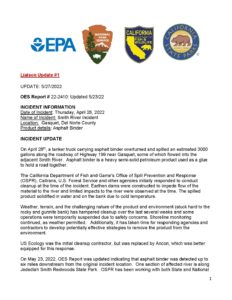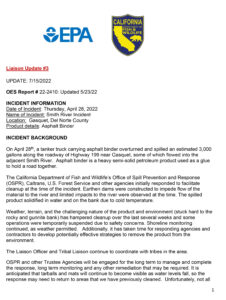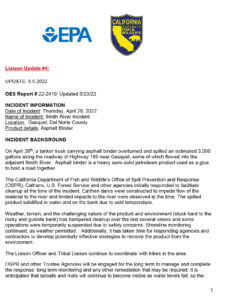
Middle Fork Smith River Tar Spill
July 2022 Update on Cleanup and Monitoring Efforts

Image provided by California Department of Fish and Wildlife Office of Spill Prevention and Response.
California Department of Fish and Wildlife (CDFW) have concluded cleanup efforts at initial spill site on US-199 and hillside along the Smith River as of July 13, 2022.
Cleanup crews are still recovering tar balls along exposed gravel bars and underwater by dive crews downstream from the spill site.
As the river continues to drop due to drought conditions, cleanup crews are finding additional tar balls along rock bars.Cleanup crews will continue to remain in the area conducting surveys and clean up efforts along the Smith River.
On July 13, Dive contractors assessed and recovered sunken oil downstream from the spill site to Myrtle Creek. CDFW is working with dive contractors to continue to conduct dive surveys and cleanups.
CDFW announced that no cleanup efforts have started west of US-101, but is coordinating and consulting with Tolowa Dee-Ni’ Nation for these operations.
May 2022 Update on the Spreading Sludge
Recently, residents and visitors along the Smith River in Hiouchi (home to the Jedediah Smith State Park Campground) have reported black globs of tar in the water, on rocks and plants.
Video provided by a concerned citizen regarding asphalt tar contaminating the Middle Fork of the Smith River on May 22, 2022. Due to high temperatures and sun, the tar is slowly flowing into the Smith.
Report for Smith River Spill 25 May 2022 by Craig Strong, Crescent Coastal Research
I visited the river again today at 0600 to clean up Asphalt sealer tar on the beach along the gravel bar in Hiouchi (410 47’ 16.6” N, 1240 03’ 29.6” W, pieces of material were found up to 300 m above and below that location).
The material was indeed easier to remove during the cool morning temperatures (about 530 F); it cracked into pieces rather than having a gooey texture. However, tar patches that had melted in prior days heat onto willow branches or in among rocks was essentially unrecoverable without more equipment and manpower.
It was noted that small pieces were being deposited at the current water line, ie: recently arrived from the spill site. The larger globs are now from 1 to 2.5 feet above current river levels, suggesting that a large flow of the contaminant occurred between 10 days and 2 weeks ago when the weather started warming.
In roughly 1.2 hours I picked up 34 globs of sealer ranging in size from about 0.4 inches to 6 x 10 inches, mostly of less that 2 inches across. These weighted approximately 4 pounds, but with an additional 4 pounds of pebbles and vegetation they were glued to. Most larger pieces had melted into the substrate and were unrecoverable.
April 2022 Toxic Spill in the Middle Fork Smith River
On April 28, a semi-truck, containing an estimated 2,000 gallons of asphalt tar, collided with a power pole on U.S. Highway 199 and delivered a payload of contamination, potentially harmful to fish, plants, wildlife and humans into the Middle Fork of the Smith River. The driver of the truck was arrested on suspicion of driving under the influence of alcohol and a misdemeanor hit and run. Read the Wild Rivers Outpost story about the event here.
In the week following the toxic spill, the road was cleaned, limited material was removed from the site and some cleanup efforts were made by US Forest Service, CalTrans and California Department of Fish and Wildlife. Authorities said that the hot asphalt binder will have little impact and spread as it solidifies in cold water.
Liaison Update #1 (5/27/2022)
LIAISON UPDATE #1
UPDATED 5/27/2022
OES Report # 22-2410
Prepared by the U.S. Environmental Protection Agency, National Park Service, California Department of Fish & Wildlife and California State Parks.

Liaison Update #2 (6/03/2022)
LIAISON UPDATE #2
UPDATED 6/3/2022
OES Report # 22-2410
Prepared by the U.S. Environmental Protection Agency, National Park Service, California Department of Fish & Wildlife and California State Parks.

Liaison Update #3 (7/14/2022)
LIAISON UPDATE #3
UPDATED 7/15/2022
OES Report # 22-2410
Prepared by the U.S. Environmental Protection Agency and California Department of Fish & Wildlife.

Liaison Update #4 (8/05/2022)
LIAISON UPDATE #4
UPDATED 8/05/2022
OES Report # 22-2410
Prepared by the U.S. Environmental Protection Agency and California Department of Fish & Wildlife.

What is this substance?
The asphalt substance was spilled on U.S. 199 on April 28, 2022 and is leaking into the river.
The Safety Data Sheet on the asphalt substance can be found here.
Jed Smith State Park Campground Riparian Area Sullied by Tar
Park staff report that the black asphalt tar has reached the beach in Jed Smith State Park, about 6 miles from the original spill site. A quarter of a mile of beach was inspected along the bank of Smith River at the Jed Smith Campground and the black globs of tar were found at fifteen locations close to and at the waterline.
Jed Smith Campground and Day-Use Area is one of the most popular north coast destinations and families will be swimming and recreating in and amongst these tar sites. The black tar is tacky to the touch and becomes gooey as the days warm. Regardless of toxicity, the material poses detrimental impacts to wildlife that encounter the material.










